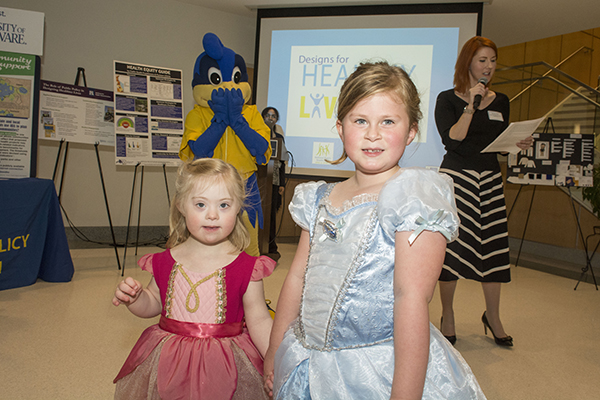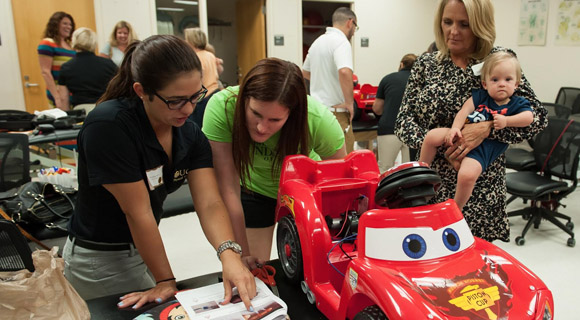FUNctional Fashion Show, Cross-disciplinary Solutions
Designs for Healthy Living
Exhibition features FUNctional fashion show, cross-disciplinary solutions
“Everyone wants to know why a physical therapy department would need a fashion designer,” says Hall, who teaches in the Department of Fashion and Apparel Studies but is also part of a team that designs, makes prototypes and tests garment-based devices for kids with special needs.
This spring, those two interests came together when Hall taught a new childrenswear course called FUNctional Fashion, which paired apparel students and kids to co-design garments that would address specific clothing-related challenges.
The FUNctional Fashion Team, which runs under the GoBabyGo umbrella, is led by Michele Lobo, assistant professor of physical therapy.
On the evening of April 10, a “red carpet” was laid out in the Health Sciences Complex atrium at UD’s Science, Technology and Advanced Research (STAR) Campus for a princess, a ninja and other young fashionistas to show off their style to attendees at the Designs for Healthy Living Exhibition.
In addition to the fashion show, the exhibition featured research addressing a broad range of health issues, from human and animal health to physical and emotional health to the health of society and the planet. The exhibition was curated by Dilia Lopez-Gydosh, assistant professor of fashion and apparel studies.
“Innovation happens when we collaborate with others who have a completely different toolbox than we do,” Hall said in welcoming community members and University faculty, staff and students to the event. “We can show one another new ways of addressing health challenges that really make a significant impact.”
Exhibits and demonstrations from four of UD’s seven colleges highlighted a broad range of topics including zero waste fashions, devices to facilitate mobility, food safety, community health promotion and interpretive horticulture.
Kids played with adapted toy race cars, and families lined up at the GoBabyGo Café for complimentary ice cream from the UDairy Creamery, while representatives of UD’sHealthcare Theatre Program demonstrated devices that provide realistic training for nursing students.
Senior apparel design student Dani Civil created a princess dress for 4-year-old Natalie, who has Down syndrome, in Hall’s FUNctional Fashion class.
“Natalie’s older sister, Hannah, has commercial princess dresses that Natalie wanted to wear, but the fit and closures of these dresses weren’t working for her,” Hall said in announcing the young model’s walk down the runway during the fashion show.
For Civil, her client’s excitement about the “pink ponte knit tea-length dress with full tulle skirt and chiffon cap sleeves” made the project very rewarding.
“It meant so much to me to do this for Natalie with input from her and her family,” Civil said. “Everything else I’ve made has been for me.”
Hall would like to teach the class again, and she also plans to continue her quest to bring together people whose paths might not otherwise cross at UD.
“Working with Michele Lobo and Cole Galloway in the GoBabyGo Program has been one of the best things that ever happened to me professionally,” Hall says. “I can’t imagine a better place to apply my skills as a designer. Initiatives like Design for Healthy Living are a way to bring researchers from different areas of UD together, sharing interests in similar topics.”
Ashley Pigford, assistant professor of visual communications in UD’s Department of Art, came to the exhibition to engage the public with robots making art.
“The idea behind this is to teach technology as a means rather than an end,” he said.
Pigford shared space at the exhibition with a registered student organization, Design, Innovation, and Positivity, which “connects students that have ideas with students that can take those ideas to the next level.”
That’s exactly what Hall had in mind when she launched Designs for Healthy Living.
Article by Diane Kukich | Video by Ashley Barnas | Photos by Doug Baker


 UCF Provides Modified Kiddie Cars to Special Brevard Toddlers
UCF Provides Modified Kiddie Cars to Special Brevard Toddlers